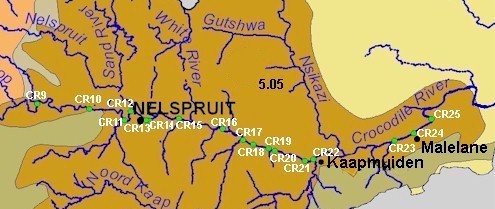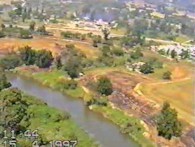| RHP |
South African
River Health Programme |
State of the Rivers Report
Crocodile, Sabie-Sand & Olifants River Systems |












|
|
The Crocodile River System Ecoregion 5.05 |
||
|
Ecoregion and River Characteristics This ecoregion is typical of lower escarpment reaches and the start of the lowveld. Altitude range falls to 800-1 000 m, with moderate relief. The rainfall is variable within the ecoregion with some areas receiving as little as 400 mm per year, although most areas receive within 600 to 1 000 mm. Temperatures are higher (16-22°C), and soils are sandy, sandy loams, and clays overlaying iron, jaspilite, syenite, hornblende granite, foskorite, and gneiss, which is conducive to a shift in vegetation from grassland to bushveld. The river in this long section is mostly characterised by large rocky pools with occasional rapids. Upstream from Kaapmuiden the river flows through a gorge where rocky habitats and big boulders abound. Present Ecological State The overall state of this section can be described as fair . Upstream from Nelspruit the in-stream biota reflect a good to fair ecological state. Around Nelspruit the in-stream and riparian conditions deteriorate as indicated by riparian habitats and vegetation ( poor ), fish ( fair to poor ) and invertebrates ( poor to unacceptable ). Downstream from Nelspruit the river gradually recovers to a fair state. |
||
|
||
|
Drivers of Ecological Change (Land-use activities)
This section is under pressure from intensive agricultural, industrial and urban land uses. Large areas are used for irrigated agriculture, ranging from fruit (predominantly citrus) orchards to vegetable and tobacco cultivation. |
||
|
||
|
Desired Ecological State and Response by Resource Managers It is desirable to manage this section of the Crocodile Catchment to achieve a
good
ecological state. This is regarded as an achievable and realistic goal. The biggest challenge is in the vicinity of Nelspruit, where multiple disturbances need to be managed. These disturbances include disposal of solid wastes that often ends up in and close to the river, and the quality of effluents that are being discharged.
|
||






